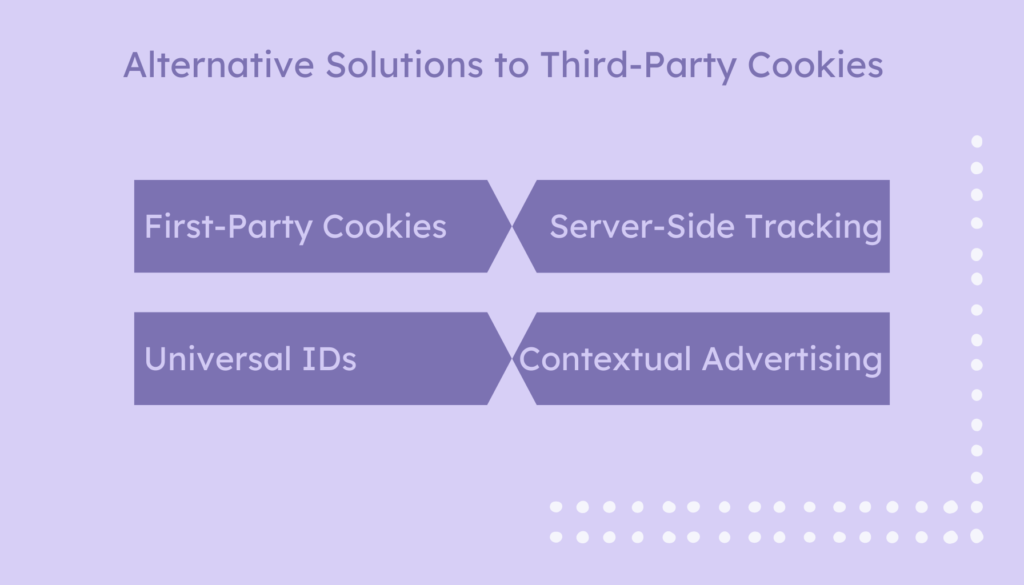
Introduction
Third-party cookies have been the cornerstone of online advertising and tracking for many years, allowing businesses to target users with personalized ads based on their browsing history. However, as privacy concerns have grown and regulations like GDPR and CCPA have been introduced, many browsers have started phasing out third-party cookies. This is a significant challenge for marketers who rely on cookies to retarget users and drive conversions.
In this article, we’ll take a closer look at third-party cookies, their impact on user privacy, and why they’re going away. We’ll also explore alternative solutions to third-party cookies; such as leveraging first-party cookies, universal IDs, and server-side tracking.
2.5x better ad results with cookieless retargeting
Create high-converting retargeting ads based on your users' real-time intent.

Understanding Third-Party Cookies
Third-party cookies are small text files that websites place on a user’s computer or mobile device to track their browsing behavior. Unlike first-party cookies, which are set by the website the user is visiting, third-party cookies are set by domains that the user hasn’t directly interacted with.
Here’s how it works: when a user visits a website that uses third-party cookies, the website will load code from a third-party domain, such as an ad network or analytics provider. This code will set a cookie on the user’s device, allowing the third party to track the user across different websites and collect data about their browsing behavior.
For example, if you visit an online clothing store that uses third-party cookies, you may see ads for that store or similar products on other websites you visit, even if you don’t explicitly search for those items. This is because third-party cookies track your behavior on the clothing store website and use that data to serve targeted ads.
The Impact of Third-Party Cookies On User Privacy
Third-party cookies have been the subject of much controversy due to their concerns surrounding user privacy. The use of third-party cookies allows companies to collect vast amounts of data about users without their explicit consent or knowledge. This data can include information about a user’s browsing history, search queries, and even personal details like age, gender, and location.
Naturally, many users are uncomfortable with the idea of their online behavior being tracked, especially without their consent. This has led to the introduction of privacy regulations like GDPR and CCPA, which require companies to obtain explicit consent from users before collecting their data.
Moreover, third-party cookies are always vulnerable to hacking and misuse. If a third-party domain is compromised, hackers can potentially access the data collected through third-party cookies, putting user privacy at risk.
The Risks Associated with Third-Party Cookies
Aside from privacy concerns, third-party cookies also pose other risks. For example, third-party cookies can slow down website loading times, affecting the user experience. This is because each time a user visits a website that uses third-party cookies, their device must make additional requests to load data from the third-party domain.
Third-party cookies can be used to serve malicious content, such as malware or phishing scams. Hackers can use third-party cookies to track a user’s behavior to serve them targeted ads that install malware on their device or lead to fraudulent websites.
Overall, the use of third-party cookies raises significant privacy and security concerns. It’s important for marketers to be aware of these risks and consider alternative solutions to protect user privacy and ensure a positive user experience.
As a result of these privacy and security concerns, several web browsers, including Safari, Firefox, and most recently, Google Chrome, have announced plans to phase out support for third-party cookies. This move has been driven by a desire to give users more control over their online data.
While it presents challenges, it also creates opportunities to find new and innovative ways to engage with users while respecting their privacy.
When Will the ‘Cookie Apocalypse’ Take Place?
Google originally announced its plans to phase out support for third-party cookies by 2022. However, in March 2021, they decided to extend the timeline of phasing out third-party cookies. The exact timeline is now uncertain, but they have stated that they plan to phase out support for third-party cookies within two years, which means it could happen as early as this year (2023).
Google’s plan for phasing out support for third-party cookies in Chrome is part of a broader effort to build a more private and secure web. They have stated that their goal is to develop a new set of web technologies that will replace the functionality of third-party cookies while protecting user privacy.

To achieve this goal, Google is working on developing a new privacy-focused API called the Privacy Sandbox. The Privacy Sandbox is a set of APIs that will enable targeted advertising and other types of user tracking while preserving user privacy. The Privacy Sandbox aims to provide a more transparent and secure approach to user tracking and advertising, allowing users to have more control over their data.
Google has proposed several new technologies as part of the Privacy Sandbox, including:
- Federated Learning of Cohorts (FLoC): This technology groups users with similar browsing histories into “cohorts” and assigns them a unique identifier. Advertisers can then target ads to specific cohorts rather than individual users, preserving user privacy while still allowing for personalized advertising.
- Trust Tokens: Trust Tokens are a new type of authentication token that can be used to verify user identities without using third-party cookies. This technology aims to provide a more secure and transparent approach to user authentication.
- TURTLEDOVE: This technology allows advertisers to bid on ad impressions without seeing any user data. User data is only shared with the advertiser that wins the bid, preserving user privacy.
Google is currently testing these technologies in Chrome and working with industry stakeholders to refine and improve them. While the exact timeline of phasing out third-party cookies is uncertain, these changes have already had an impact on the advertising industry and are driving the exploration of alternative solutions such as first-party data and cookieless tracking.
Alternative Solutions to Third-Party Cookies
As third-party cookies are being phased out, marketers need to explore alternative approaches to user tracking and advertising. Here are some of the most promising alternatives to third-party cookies for marketers.
1. First-Party Cookies
First-party cookies are cookies that are set by the website that the user is visiting. Unlike third-party cookies, first-party cookies are not shared with other websites or third-party advertisers.
- Pros: First-party cookies are a well-established technology that is already widely used by marketers. They provide a way to track user behavior on your own website and deliver personalized advertising.
- Cons: First-party cookies are limited in scope compared to third-party cookies. They only allow you to track user behavior on your own website, which means that you may miss out on valuable user data from third-party websites.
2. Universal IDs
Universal IDs are unique identifiers that are used to track user behavior across multiple websites and platforms. Unlike third-party cookies, universal IDs are not stored on the user’s device and are not shared with third-party advertisers. Instead, they are stored in a centralized database and used to track user behavior across multiple websites.
- Pros: Universal IDs can be valuable for delivering personalized advertising. They also provide a more transparent and secure approach to user tracking than third-party cookies.
- Cons: Universal IDs require cooperation from multiple publishers and platforms to be effective. Finding a solution that easily integrates with advertising platforms and enables you to run cross-channel campaigns, such as Pathmonk Retargeting, will make this technology the most viable for marketers.
2.5x better ad results with cookieless retargeting
Create high-converting retargeting ads based on your users' real-time intent.

3. Server-Side Tracking
Server-side tracking is a technique that involves tracking user behavior on the server rather than the client side.
- Pros: Server-side tracking provides a more accurate and secure approach to user tracking than client-side tracking. It can also provide better protection against ad fraud.
- Cons: Server-side tracking requires more technical expertise than client-side tracking. It can also be more expensive to implement and maintain.
4. Contextual Advertising
Contextual advertising involves targeting ads based on the content of the webpage rather than user behavior.
- Pros: Contextual advertising provides a more privacy-friendly approach to advertising. It also allows advertisers to deliver more relevant ads based on the content of the webpage.
- Cons: Contextual advertising is less precise than other forms of advertising that rely on user behavior. It also requires more manual intervention from marketers to ensure that ads are targeted correctly.

Conclusion
Overall, the phasing out of third-party cookies is a significant shift for marketers. While it presents challenges, it also creates opportunities to find innovative ways to engage with users while respecting their privacy.
There are several alternatives to third-party cookies that marketers can leverage to deliver personalized advertising and track user behavior. Each alternative has its pros and cons, and marketers need to consider their specific needs and goals when deciding which approach to take. Some alternatives may require more technical expertise or cooperation from multiple publishers and platforms, while others may provide a more privacy-friendly approach to advertising. Ultimately, marketers need to stay up-to-date with the latest developments in user tracking and advertising technology to deliver effective campaigns in a post-third-party cookie world.








